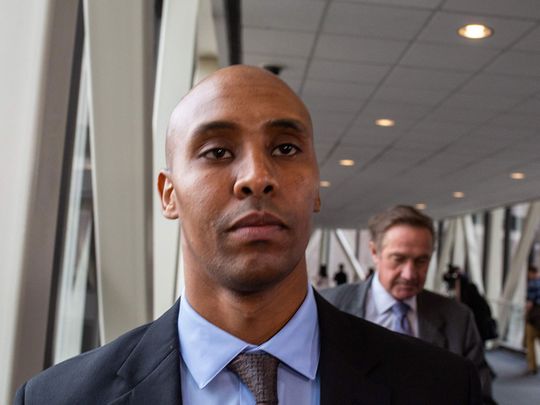
In one of the largest settlements of a case involving a fatal police shooting, the city of Minneapolis agreed on Friday to pay $20 million (Dh73.4 million) to the family of an unarmed woman who was killed by an officer when she approached his car after he responded to her 911 call.
The announcement of the settlement, by the mayor and members of the City Council, came just three days after Mohammad Noor, who is black, Somali and Muslim, became the first Minnesota police officer convicted of murder in an on-duty killing.
A jury found him guilty Tuesday in the fatal shooting of Justine Ruszczyk, 40, a yoga and meditation instructor. Ruszczyk, who was white, called 911 in July 2017 to report that she had heard a woman being attacked. After arriving in her neighbourhood, Noor fired out of his car when she approached, killing her.
His lawyers argued during the monthlong trial that Noor, who was later fired by the Police Department, had shot his gun to protect his terrified partner after hearing a thump and seeing a person by the driver’s side window raising an arm.
Prison time
Jurors convicted Noor of third-degree murder, which carries a maximum sentence of 25 years in prison, and second-degree manslaughter, which can lead to as many as 10 years in prison. Under Minnesota sentencing guidelines, he will likely face several years in prison, but far fewer than the maximum.
Her family had filed a lawsuit seeking more than $50 million from Minneapolis, saying that Ruszczyk’s civil rights had been violated.
“This is not a victory for anyone, but rather a way for our city to move forward,” Mayor Jacob Frey said as he announced the settlement. Frey said Noor’s conviction and his failure to identify a threat before he used deadly force had pushed the city to quickly settle.
Experts thought the settlement was necessary. “A jury could give $100 million, so they wanted to avoid that,” said Walter Signorelli, a lawyer who represents clients suing the police, who is also a former deputy inspector for the New York City Police Department.
But social justice advocates, who have already noted what they see as troubling racial dimensions of the case, said the unusually large settlement further illuminates the difference between white and black victims of police violence.
“The fact that this is the largest known case of a police abuse settlement in the history of Minneapolis, and that it’s on behalf of an affluent white woman, reinforces that there are two systems,” said Nekima Levy Armstrong, a civil rights lawyer and activist in Minneapolis. “There are many people of colour who have not received a dime from the city in the aftermath of their loved one being shot by the police.”
The value of a life
Levy Armstrong said that government leaders were sending a signal that a white life is more valuable than a black life. She pointed to the $3 million settlement for the family of Philando Castile, a black man who was fatally shot by a police officer in a suburb of St. Paul during a traffic stop in 2016, as a prime example of the inequity. (The officer in that case was Latino; he was acquitted of manslaughter charges but left the police department.)
Ruszczyk’s family hired Robert Bennett, the Minneapolis lawyer who represented Castile’s family.
Chicago has paid two of the largest previous settlements in police shooting cases: $16 million to the family of Bettie R. Jones in 2018, and $18 million to the family of LaTanya Haggerty in 1999. The latter was believed to be the highest settlement in a fatal police shooting until Friday. Both victims were African Americans.
But nationwide, the vast majority of families who lose someone in a questionable police shooting get nothing, experts said, and many cases are dismissed before trial. Last year, a Florida jury awarded $4 to the family of a man who was killed when the police fired through his closed garage door after a dispute in which they said he was holding a gun.
Another expert said the attention on the Noor case and on the large settlement reflected how significant police shootings have become in the public eye.
“It’s a shot across the bow to cities, and shows that it’s really important to hire, train and develop police officers to avoid situations like this in the future,” said Chuck Wexler, executive director of the Police Executive Research Forum, a law enforcement policy non-profit.
Wexler said that since Michael Brown’s killing in Ferguson, Missouri, in 2014, there has been a steady focus among the big police departments that he works with on interacting with communities, especially diverse ones.
“This is tragic on a number of levels,” he said. “First, the woman who dies. But also for the Minneapolis Police Department, which reached out to the large Somali population, identified candidates, put them into the police academy and put them into uniform.”
There was already so much fear in that community, he said: “You can do everything right, and then you can have an incident that really sets you back.”












